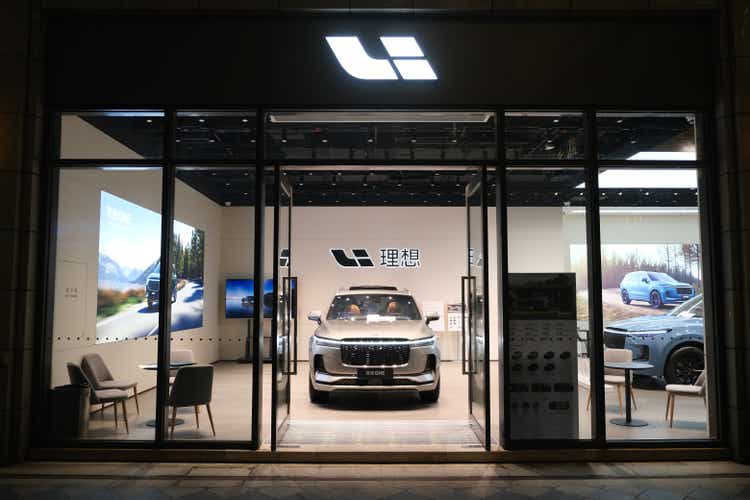Robert Way
In May 2022, we have published an article on Seeking Alpha, titled: “We Are Avoiding Li Auto Right Now“. At that time, we have rated Li Auto’s (NASDAQ:LI) stock as a “hold”, and we have highlighted some of the main concerns and risks associated with the firm in the near term, including overvaluation, macroeconomic headwinds, competition and the uncertain regulatory landscape. We have also touched upon the development of revenue and the number of deliveries, which were signaling strong growth.
Today, we will revisit Li Auto, and give our updated view on the stock. We will be focusing on new information, published since May, to argue why we still believe Li Auto is a hold.
Let us start our discussion on the more optimistic side.
Tailwinds by continued consumer adoption of NEVs
Early September, reports have suggested that auto sales in China have grown by as much as 32% year-over year.
While this figure in itself is already impressive, the sales growth of new energy vehicles is even more astonishing, as it was more than 107% year-over-year. This large increase in sales has led to a NEV penetration of a record 28%. Not only Li Auto, but many other EV makers, including Tesla (TSLA) and Nio (NIO), have also benefitted from this growth.
We believe that the push for EVs on a global scale is likely to continue both in the near- and long term. In our opinion, Li Auto is well-situated to take a meaningful portion of the Chinese market.
August earnings report
In the second quarter, LI Auto has beaten non-GAAP EPS estimates by $0.02, while it has missed on revenue by $110 million. Despite the miss on revenue, revenue has reached as much as $1.3 billion, representing a more than 73% increase YoY.
On the other hand, despite the macroeconomic challenges, the gross profit margin has reached 21.5%, compared to the 18.9% in the year ago quarter, which has been driven primarily by the higher selling prices.
During the conference call, however, risks associated with supply chains have been pointed out:
Moving to our supply chain, the COVID-19 resurgence severely affected the auto supply chain in the second quarter. Currently, there are remaining disruption and difficulties. But we moderated – they moderated as the pandemic became more campaigned.
Although we are cautiously optimistic that our supply chain will normalize in the second half of the year. We should highlight that potential volatility remain and require us to constantly stay on high alert, especially given the ongoing pandemic.
As we navigate the continuous unpredictability, we are focused on reinforcing our supply chain system, strengthening our partnership with parts suppliers to tackle parts shortage and the cost inflation and at the same time redoubled our emphasize on auto parts quality control.
This thought actually takes us to the more pessimistic side of our discussion.
Chip concerns
Due to the recently announced restrictions on chip exports from the United States, uncertainty around the China EV makers have somewhat arisen. While the current export restrictions are not likely to directly impact the automobile industry, there is no guarantee that in the future such restrictions will not be introduced. Not only EV makers, but also firms in the semiconductor space have gotten beaten up, especially Nvidia (NVDA).
In our opinion, as the geopolitical tension between China, Taiwan and the United States remains tense, the uncertainty around chip supply remains a major question and could be used to create political pressure. As the Chinese EV industry is highly dependent on the availability of chips, any shortage could lead to significant drop in production volumes. For this reason, we remain cautious with investing in LI.
Li Auto deliveries down in August by 52% year-over-year
In August, LI has delivered the second-lowest number of vehicles year to date. While the lowest numbers delivered in April were driven by COVID-19 related restrictions, in August the decline was driven by the curbed demand for the main-selling Li ONE model due to the newly launched products. On a year-to-date basis, however, the comparison looks much brighter as the number of deliveries is up 57% compared to the same period last year.
At this point, due to the Chinese zero-COVID policy, we expect further lockdowns and COVID related restrictions in the near future. As such restrictions could have a significant impact on delivery volumes, it can potentially also cause substantial volatility and further downside risk in the stock price in the near term.
Key takeaways
We believe that the macroeconomic landscape remains challenging, mainly driven by the geopolitical tensions between the U.S., China and Taiwan, and the COVID-19 related restrictions. Both of these factors could lead to supply disruptions and eventually to lower delivery volumes, which may result in further downward movement of the stock price.
As the fundamentals of the firm have not dramatically improved since the time of our last writing, our thesis about the overvaluation of the stock still remains relevant.
On the other hand, the adoption of NEVs by the Chinese consumers is creating tailwinds for the EV makers in China, including Li Auto. Further, the Q2 earnings report has suggested impressive revenue growth, combined with a widening gross profit margin, driven by the higher selling prices.
At this point, we reiterate our “hold” rating on Li Auto’s stock.


Be the first to comment